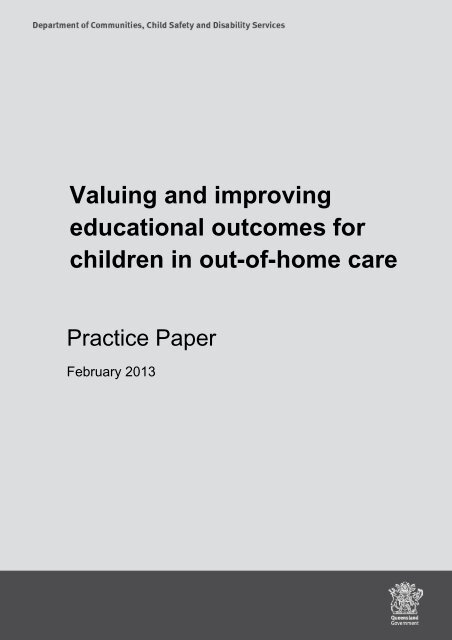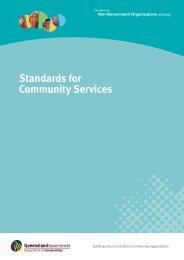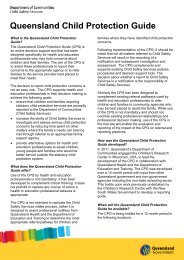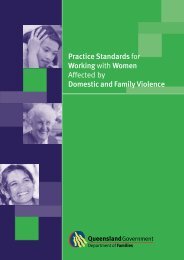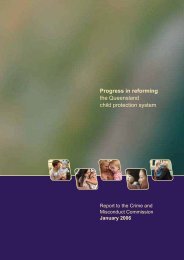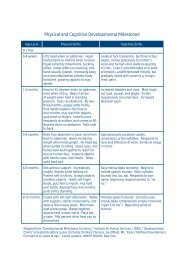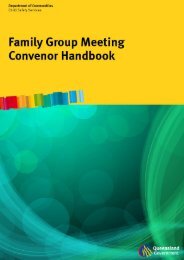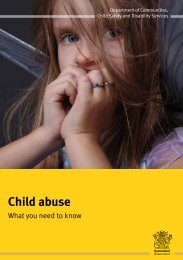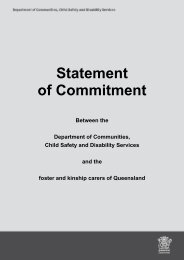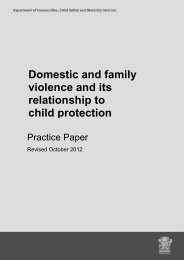Valuing and improving educational outcomes for children in out-of ...
Valuing and improving educational outcomes for children in out-of ...
Valuing and improving educational outcomes for children in out-of ...
Create successful ePaper yourself
Turn your PDF publications into a flip-book with our unique Google optimized e-Paper software.
<strong>Valu<strong>in</strong>g</strong> <strong>and</strong> <strong>improv<strong>in</strong>g</strong><strong>educational</strong> <strong><strong>out</strong>comes</strong> <strong>for</strong><strong>children</strong> <strong>in</strong> <strong>out</strong>-<strong>of</strong>-home carePractice PaperFebruary 2013
IntroductionChildren <strong>in</strong> <strong>out</strong>-<strong>of</strong>-home care may have a range <strong>of</strong> needs that require sensitive <strong>and</strong> plannedresponses. One <strong>of</strong> their needs is to have positive <strong>and</strong> successful <strong>educational</strong> experiences.The engagement <strong>of</strong> <strong>children</strong> <strong>and</strong> young people <strong>in</strong> education is recognised as a critical issuethat warrants the same level <strong>of</strong> attention as other aspects <strong>of</strong> their wellbe<strong>in</strong>g.This paper exam<strong>in</strong>es the research on <strong>children</strong> <strong>in</strong> <strong>out</strong>-<strong>of</strong>-home care <strong>and</strong> education. Ithighlights that education should be a priority <strong>for</strong> child welfare <strong>and</strong> education pr<strong>of</strong>essionals.Children <strong>in</strong> <strong>out</strong>-<strong>of</strong>-home care can have positive <strong>and</strong> life-chang<strong>in</strong>g <strong>educational</strong> experiences ifall stakeholders commit <strong>in</strong> a coord<strong>in</strong>ated <strong>and</strong> <strong>in</strong><strong>for</strong>med manner to facilitat<strong>in</strong>g young people’s<strong>educational</strong> journeys.Although some <strong>of</strong> the research f<strong>in</strong>d<strong>in</strong>gs <strong>and</strong> evidence <strong>in</strong> this paper are specific to theexperiences <strong>of</strong> adolescent young people <strong>in</strong> <strong>out</strong>-<strong>of</strong>-home care, the <strong>in</strong><strong>for</strong>mation has broaderapplication to the <strong>educational</strong> needs <strong>and</strong> experiences <strong>of</strong> <strong>children</strong> <strong>in</strong> <strong>out</strong>-<strong>of</strong>-home care whoare <strong>of</strong> a younger age.Status <strong>of</strong> education <strong>for</strong> <strong>children</strong> <strong>in</strong> <strong>out</strong>-<strong>of</strong>-home careCompared to the non [<strong>out</strong>-<strong>of</strong>-home] care population, <strong>children</strong> <strong>in</strong> <strong>out</strong>-<strong>of</strong>-home care <strong>in</strong> manyjurisdictions are an at-risk group <strong>for</strong> reduced <strong>educational</strong> per<strong>for</strong>mance (Forsmana &V<strong>in</strong>nerljunga, 2012; Francis, 2000). A number <strong>of</strong> issues have been raised ab<strong>out</strong> youngpeople <strong>in</strong> <strong>out</strong>-<strong>of</strong>-home care, <strong>and</strong> <strong>in</strong>dicate they: may not realise their academic potential <strong>and</strong> not achieve <strong>educational</strong> qualifications(see Connelly & Chakrabarti, 2008; Forsman & V<strong>in</strong>nerljunga, 2012; Francis, 2000)are over-represented <strong>in</strong> special education (Stone, 2007; Tr<strong>out</strong> et al, 2008). Zetl<strong>in</strong>(2006) suggests that <strong>children</strong> <strong>in</strong> <strong>out</strong>-<strong>of</strong>-home care are more <strong>of</strong>ten <strong>in</strong> receipt <strong>of</strong> specialeducation services than the general population. Conversely, <strong>for</strong> other young people<strong>in</strong> <strong>out</strong>-<strong>of</strong>-home care they may miss <strong>out</strong> on special education services because <strong>of</strong>school changes <strong>and</strong> not be<strong>in</strong>g appropriately assessed. Further, some young peoplemay experience compounded difficulties because <strong>of</strong> the risks associated withdisability/special education <strong>and</strong> be<strong>in</strong>g <strong>in</strong> foster care (Geenen & Powers, 2006)may not per<strong>for</strong>m well academically <strong>and</strong> may per<strong>for</strong>m below their grade level orunderachieve (Tr<strong>out</strong> et al, 2008; Dilla, Flynn, Holl<strong>in</strong>gshead & Fern<strong>and</strong>es, 2012;Berl<strong>in</strong>, V<strong>in</strong>nerljung & Hjern, 2011)can miss <strong>out</strong> on academic concepts due to <strong>in</strong>stability, placement changes <strong>and</strong> theassociated disruption (Malmgren & Meisel, 2002 cited <strong>in</strong> Tr<strong>out</strong> et al, 2008, Tilbury,2010). Kirk <strong>and</strong> Day (2011) highlight with reference to McNaught (2009) that studentscan be disadvantaged by 4 to 6 months from school changes due to lack <strong>of</strong>coord<strong>in</strong>ation between welfare <strong>and</strong> education systems <strong>and</strong> paper trail/record delaysare less likely to progress to tertiary or other post secondary education (Kirk & Day,2011; Forsman & V<strong>in</strong>nerljunga, 2012; Dworsky, 2010). For young people<strong>Valu<strong>in</strong>g</strong> <strong>and</strong> <strong>improv<strong>in</strong>g</strong> <strong>educational</strong> <strong><strong>out</strong>comes</strong> <strong>for</strong> <strong>children</strong> <strong>in</strong> <strong>out</strong>-<strong>of</strong>-home care February 2013 Page 3 <strong>of</strong> 23
impact <strong>of</strong> maltreatment can contribute significantly to <strong>children</strong> hav<strong>in</strong>g difficulty at school(Frederick & Goddard, 2010; Mart<strong>in</strong> & Jackson, 2002; Wise et al, 2010; Cole et al, 2005).Besides the impact <strong>of</strong> harm, other pre [<strong>out</strong>-<strong>of</strong>-home] care circumstances can affect a youngperson’s <strong>educational</strong> experience. For example, poverty <strong>and</strong> economic disadvantage mayrestrict opportunities <strong>for</strong> <strong>children</strong> (Flynn et al, 2010) as does a lack <strong>of</strong> <strong>educational</strong>encouragement <strong>and</strong> preparation <strong>for</strong> <strong>children</strong> from significant others. When <strong>children</strong> enter <strong>out</strong><strong>of</strong>-homecare they may have experienced a range <strong>of</strong> disadvantages which they br<strong>in</strong>g to boththe <strong>out</strong>-<strong>of</strong>-home care <strong>and</strong> school sett<strong>in</strong>gs (Borl<strong>and</strong> et al, 1998; Rutter, 2000 cited <strong>in</strong> Harker etal, 2004; Frederick & Goddard, 2010; Wise et al, 2010; W<strong>in</strong>ter et al, 2011).In [<strong>out</strong>-<strong>of</strong>-home] care factors can also contribute to why <strong>children</strong> <strong>in</strong> <strong>out</strong>-<strong>of</strong>-home care mayhave academic problems (W<strong>in</strong>ter et al, 2011). For some <strong>children</strong>, be<strong>in</strong>g <strong>in</strong> <strong>out</strong>-<strong>of</strong>-home careresults <strong>in</strong> a journey <strong>of</strong> disruption, discont<strong>in</strong>uity <strong>and</strong> commitments comprised <strong>of</strong> placementchanges, school transfers, court appearances, contact visits, therapeutic services <strong>and</strong> otherrequirements (Tilbury et al, 2009; Frederick & Goddard, 2010). At times, these dem<strong>and</strong>s can<strong>and</strong> will create discont<strong>in</strong>uities <strong>for</strong> <strong>children</strong> with schools, teachers, peers <strong>and</strong> friends (Tr<strong>out</strong> etal, 2008). The tim<strong>in</strong>g <strong>of</strong> these changes may not always be optimal <strong>for</strong> these <strong>children</strong> <strong>in</strong> terms<strong>of</strong> curriculum <strong>and</strong> engagement (Jackson, 1989 cited <strong>in</strong> Goddard, 2000). For some <strong>children</strong>,these changes may also lead to an escalation <strong>in</strong> behavioural difficulties when at school.They are attempt<strong>in</strong>g to manage feel<strong>in</strong>gs <strong>of</strong> stress, loss <strong>and</strong> hav<strong>in</strong>g to adapt to unfamiliarpeople <strong>and</strong> environments (Sullivan, Jones & Mathiesen, 2010).In addition, high mobility, placement <strong>and</strong> school changes can result <strong>in</strong> <strong>children</strong> not hav<strong>in</strong>g aconstant supporter <strong>of</strong> their education, who can advocate <strong>for</strong> their <strong>educational</strong> needs <strong>and</strong> iswell-<strong>in</strong><strong>for</strong>med <strong>of</strong> their capabilities <strong>and</strong> limits (Allen & Vacca, 2010; Zetl<strong>in</strong>, We<strong>in</strong>berg & Kimm,2004). A lifestyle characterised by <strong>in</strong>stability is recognised as a contribut<strong>in</strong>g factor to<strong>educational</strong> difficulties (Jackson, 1998; Francis, 2000; Jackson <strong>and</strong> Thomas, 2001; Evans,2003 cited <strong>in</strong> O’Sullivan & Westerman, 2007).Absences <strong>for</strong> any reason can lead to a heightened risk <strong>of</strong> <strong>children</strong> disengag<strong>in</strong>g with, or notfeel<strong>in</strong>g a sense <strong>of</strong> belong<strong>in</strong>g to, a school (Smithgall, Jarpe-Ratner & Walker, 2010; Wise etal, 2010). How engaged <strong>children</strong> feel at school, whether this be at an “emotional”, “cognitive”or “behavioural” level can <strong>in</strong>fluence their perception <strong>of</strong> school <strong>and</strong> ultimately their will<strong>in</strong>gness<strong>and</strong> motivation to attend (Fredricks, Blumenfeld & Paris, 2004, p 60).Further compound<strong>in</strong>g the discont<strong>in</strong>uity issue is that there may be a lack <strong>of</strong> effectivecommunication between pr<strong>of</strong>essionals <strong>in</strong>volved <strong>in</strong> a young person’s life ab<strong>out</strong> their<strong>educational</strong> atta<strong>in</strong>ment <strong>and</strong> needs when changes take place (Vacca, 2006, cited <strong>in</strong> Vacca,2008, Harker et al, 2004). Delays <strong>in</strong> the transfer <strong>of</strong> <strong>in</strong><strong>for</strong>mation ab<strong>out</strong> a child’s <strong>educational</strong>status may result (Zetl<strong>in</strong>, We<strong>in</strong>berg & Kimm, 2004). Harker et al (2004) also adds that<strong>in</strong>sufficient monitor<strong>in</strong>g <strong>and</strong> record keep<strong>in</strong>g <strong>of</strong> <strong>in</strong> [<strong>out</strong>-<strong>of</strong>-home] care <strong>children</strong>’s <strong>educational</strong>progress <strong>and</strong> schools attended can occur. Some schools may not even be <strong>in</strong><strong>for</strong>med <strong>of</strong> achild’s <strong>out</strong>-<strong>of</strong>-home care status. Education <strong>and</strong> school stability has also not always been apriority when pr<strong>of</strong>essionals are organis<strong>in</strong>g <strong>out</strong>-<strong>of</strong>-home care placements (Harker et al, 2004).Some research has suggested that type <strong>of</strong> placement may be related to <strong>educational</strong><strong><strong>out</strong>comes</strong> <strong>for</strong> <strong>children</strong> <strong>in</strong> <strong>out</strong>-<strong>of</strong>-home care. Provisionally, it has been suggested that <strong>children</strong><strong>Valu<strong>in</strong>g</strong> <strong>and</strong> <strong>improv<strong>in</strong>g</strong> <strong>educational</strong> <strong><strong>out</strong>comes</strong> <strong>for</strong> <strong>children</strong> <strong>in</strong> <strong>out</strong>-<strong>of</strong>-home care February 2013 Page 5 <strong>of</strong> 23
<strong>in</strong> family <strong>and</strong> k<strong>in</strong> placements are more likely to achieve better <strong>educational</strong> <strong><strong>out</strong>comes</strong> thanother types <strong>of</strong> placements such as group homes <strong>and</strong> therapeutic foster care (Berrick, Barth& Needell, 1994; Zima et al., 2000 cited <strong>in</strong> Cheung et al, 2012). This suggests that <strong>children</strong><strong>in</strong> some types <strong>of</strong> placements may be particularly vulnerable.The expectations <strong>and</strong> aspirations <strong>of</strong> those significantly <strong>in</strong>volved <strong>in</strong> a young person’s<strong>educational</strong> journey can impact on <strong>educational</strong> atta<strong>in</strong>ment. Some research has reported thatcarers <strong>and</strong> teachers may not expect <strong>children</strong> <strong>in</strong> [<strong>out</strong>-<strong>of</strong>-home] care to do well (Mart<strong>in</strong> &Jackson, 2002; Harker et al, 2004; Francis, 2000), or expect difficulties <strong>in</strong> particular areas(e.g complet<strong>in</strong>g homework requirements, be a victim <strong>of</strong> bully<strong>in</strong>g) (Elliott, 2002). Elliott (2002)cites Rosenthal & Jacobson’s (1968) work on the Pygmalion Effect <strong>and</strong> the self-fulfill<strong>in</strong>gprophecy <strong>and</strong> expla<strong>in</strong>s that a person’s perspective can “create <strong>and</strong> ma<strong>in</strong>ta<strong>in</strong> a child’sper<strong>for</strong>mance level” (p. 58). Low expectations or a lack <strong>of</strong> appreciation <strong>of</strong> the importance <strong>of</strong>education can also be promoted by peers, which (if young people are mix<strong>in</strong>g with peers withthese attitudes) can be <strong>in</strong>fluential (Harker et al, 2004). Social workers have also beenidentified as not giv<strong>in</strong>g sufficient priority to <strong>in</strong> [<strong>out</strong>-<strong>of</strong>-home] care <strong>children</strong>’s educationprogress <strong>and</strong> needs (Francis, 2000) <strong>and</strong>/or focus<strong>in</strong>g on other facets <strong>of</strong> the young person’slife <strong>and</strong> wellbe<strong>in</strong>g (The Center <strong>for</strong> the Future <strong>of</strong> Teach<strong>in</strong>g <strong>and</strong> Learn<strong>in</strong>g <strong>and</strong> Mental HealthAdvocacy Services, Inc, 2008).With regard to transition<strong>in</strong>g from school to work Tilbury et al (2009) highlights that “at the age<strong>of</strong> 17 or 18 years, when many young people are leav<strong>in</strong>g school <strong>and</strong> start<strong>in</strong>g work or furtherstudy with the help <strong>of</strong> their parents, <strong>children</strong> <strong>in</strong> <strong>out</strong>-<strong>of</strong>-home care generally negotiate thesechanges when the <strong>for</strong>mal supports <strong>of</strong> the care system such as a case worker, f<strong>in</strong>ancialassistance <strong>and</strong> a foster home, are ceas<strong>in</strong>g (Courtney & Dworsky, 2006; Mendes &Moslehudd<strong>in</strong>, 2004; Ste<strong>in</strong>, 2006)”(p. 477). Many young people may lack support fromsignificant others <strong>and</strong> their community (Lips, 2007 cited <strong>in</strong> Allen & Vacca, 2010). Such issuescan <strong>and</strong> will impact on a young person’s aspirations, atta<strong>in</strong>ment <strong>and</strong> ultimately,achievements. Importantly, many young people <strong>in</strong> <strong>out</strong>-<strong>of</strong>-home care may aspire to higheducation but may not have the means or support to progress this goal (Dworsky, 2010).Key messagesChildren <strong>in</strong> <strong>out</strong>-<strong>of</strong>-home care are an at risk group <strong>for</strong> less desirable <strong>educational</strong><strong><strong>out</strong>comes</strong> compared to the non [<strong>out</strong>-<strong>of</strong>-home] care population.Research has reported that <strong>children</strong> <strong>in</strong> <strong>out</strong>-<strong>of</strong>-home care may not reach theiracademic potential, be over-represented <strong>in</strong> special education, per<strong>for</strong>m below theirgrade level <strong>and</strong> are less likely to progress to tertiary or other post secondaryeducation. However, there is variation <strong>in</strong> the capability <strong>and</strong> academic atta<strong>in</strong>ment <strong>of</strong><strong>children</strong> <strong>in</strong> <strong>out</strong>-<strong>of</strong>-home care.Some <strong>children</strong> <strong>in</strong> <strong>out</strong>-<strong>of</strong>-home care may have behavioural difficulties which canheighten their risk <strong>for</strong> <strong><strong>out</strong>comes</strong> such as drop-<strong>out</strong>, truancy, repeat<strong>in</strong>g grades,suspensions <strong>and</strong> exclusions.The follow<strong>in</strong>g risks, barriers or reasons have been suggested <strong>for</strong> why <strong>children</strong> <strong>in</strong> <strong>out</strong>-<strong>Valu<strong>in</strong>g</strong> <strong>and</strong> <strong>improv<strong>in</strong>g</strong> <strong>educational</strong> <strong><strong>out</strong>comes</strong> <strong>for</strong> <strong>children</strong> <strong>in</strong> <strong>out</strong>-<strong>of</strong>-home care February 2013 Page 6 <strong>of</strong> 23
<strong>of</strong>-home care may have <strong>educational</strong> difficulties. The impact <strong>of</strong> abuse <strong>and</strong> harm can affect all doma<strong>in</strong>s <strong>of</strong> the child’s development– motor, social, psychological, physical <strong>and</strong> cognitive. Harm can also impact on achild’s learn<strong>in</strong>g <strong>and</strong> academic per<strong>for</strong>mance <strong>and</strong> social relationships. A child’s pre [<strong>out</strong>-<strong>of</strong>-home] care circumstances, <strong>for</strong> example, lack <strong>of</strong> <strong>educational</strong>encouragement <strong>and</strong> preparation by significant others, can impact on theiracademic <strong>and</strong> social capacity. Out-<strong>of</strong>-home care factors can contribute to a child’s academic problems.Placement changes, school transfers, court appearances, contact visits,attendance at therapeutic services <strong>and</strong> other commitments can causeconsiderable disruption <strong>and</strong> discont<strong>in</strong>uity to a child’s education <strong>and</strong>connectedness to the school environment. Absences <strong>for</strong> any reason can impacton a child’s progress. When <strong>children</strong> do change school, <strong>in</strong>sufficient communication <strong>and</strong>/or delays <strong>in</strong>transfer <strong>of</strong> <strong>in</strong><strong>for</strong>mation by pr<strong>of</strong>essionals (ab<strong>out</strong> a child’s <strong>educational</strong> status <strong>and</strong>needs), may occur. Also, <strong>in</strong>sufficient monitor<strong>in</strong>g <strong>and</strong> record keep<strong>in</strong>g <strong>of</strong> <strong>children</strong>’s<strong>educational</strong> progress <strong>and</strong> schools attended may result, <strong>and</strong> some schools maynot be <strong>in</strong><strong>for</strong>med that a child is <strong>in</strong> <strong>out</strong>-<strong>of</strong>-home care. When pr<strong>of</strong>essionals organise placements, school stability <strong>and</strong> the <strong>educational</strong>needs <strong>of</strong> <strong>children</strong> <strong>in</strong> <strong>out</strong>-<strong>of</strong>-home care are not always prioritised. Some research has suggested that some carers, social workers <strong>and</strong> teachersmay not expect <strong>children</strong> <strong>in</strong> [<strong>out</strong>-<strong>of</strong>-home] care to do well due to their care history.They may not have high expectations <strong>of</strong> these <strong>children</strong> which may be directly or<strong>in</strong>directly communicated to the child. Some young people <strong>in</strong> [<strong>out</strong>-<strong>of</strong>-home] care may not have anyone who is activelyconsider<strong>in</strong>g <strong>and</strong> discuss<strong>in</strong>g their education <strong>and</strong> career aspirations with them. Young people transition<strong>in</strong>g from school to work or post-secondary education maynot have the emotional, hous<strong>in</strong>g <strong>and</strong> f<strong>in</strong>ancial support that young people <strong>in</strong> thenon [<strong>out</strong>-<strong>of</strong>-home] care population may have to progress goals.The importance <strong>of</strong> education <strong>for</strong> <strong>children</strong> <strong>in</strong> <strong>out</strong>-<strong>of</strong>-homecareThe successful <strong>and</strong> positive completion <strong>of</strong> education <strong>for</strong> <strong>children</strong> is vital <strong>for</strong> <strong>in</strong>creas<strong>in</strong>g theirchances <strong>of</strong> successful life <strong><strong>out</strong>comes</strong>. Simply put, good <strong>educational</strong> atta<strong>in</strong>ment can lead to afulfill<strong>in</strong>g adult life (Pecora et al, 2006 cited <strong>in</strong> Driscoll, 2011).Young people who are not able to successfully complete secondary education are at risk <strong>of</strong>unemployment, be<strong>in</strong>g unable to progress a career or higher education, poverty, be<strong>in</strong>g a<strong>Valu<strong>in</strong>g</strong> <strong>and</strong> <strong>improv<strong>in</strong>g</strong> <strong>educational</strong> <strong><strong>out</strong>comes</strong> <strong>for</strong> <strong>children</strong> <strong>in</strong> <strong>out</strong>-<strong>of</strong>-home care February 2013 Page 7 <strong>of</strong> 23
ecipient <strong>of</strong> government assistance, hav<strong>in</strong>g poor self esteem, be<strong>in</strong>g less likely to participate<strong>in</strong> recreational <strong>in</strong>terests, emotional <strong>and</strong> psychosocial difficulties, homelessness, crim<strong>in</strong>ality,isolation <strong>and</strong> relationship problems <strong>and</strong> health issues (Mondy, 2009; Zetl<strong>in</strong> & We<strong>in</strong>berg,2004; Berl<strong>in</strong> et al, 2011).“Y<strong>out</strong>h that have spent at least a third <strong>of</strong> their <strong>for</strong>mative years <strong>in</strong> State care have very highexcess risks, compared to general population peers, <strong>for</strong> example, suicidal behaviour, severecrim<strong>in</strong>ality, substance abuse <strong>and</strong> welfare dependency <strong>in</strong> young adulthood. In regressionmodes, roughly 50% <strong>of</strong> these excess risks can be statistically “expla<strong>in</strong>ed” by poor schoolper<strong>for</strong>mance <strong>in</strong> primary school (Berl<strong>in</strong> et al., 2011; V<strong>in</strong>nerljung, Berl<strong>in</strong> & Hjern, 2010”(Forsman & V<strong>in</strong>nerljunga, 2012, p.1084).In many countries adequate completion <strong>of</strong> school<strong>in</strong>g is essential <strong>for</strong> young people to havethe opportunity to enter <strong>and</strong> procure employment <strong>in</strong> the labour market (Wise et al 2010). Inparticular, <strong>in</strong> today’s technologically savvy society, competency <strong>in</strong> read<strong>in</strong>g, math, technology<strong>and</strong> science is <strong>in</strong>creas<strong>in</strong>gly becom<strong>in</strong>g imperative to employment. Young people who do notacquire these basic competencies will be severely disadvantaged (Tr<strong>out</strong> et al, 2008).Conversely, young people who successfully complete school are more likely to enjoy arange <strong>of</strong> positive adult <strong><strong>out</strong>comes</strong> such as fulfill<strong>in</strong>g employment, f<strong>in</strong>ancial <strong>in</strong>dependence,positive self esteem, a sense <strong>of</strong> personal competency <strong>and</strong> <strong>in</strong>dependence, <strong>and</strong> other social<strong>and</strong> relational benefits that stem from success (Mondy, 2009; Altshuler, 2003; Hook &Courtney, 2011).The benefits <strong>of</strong> education are however much more than academic atta<strong>in</strong>ment. Attendance<strong>and</strong> participation <strong>in</strong> school <strong>of</strong>fers <strong>children</strong> the opportunity to engage <strong>in</strong> a range <strong>of</strong> socialexperiences which can provide essential developmental scaffold<strong>in</strong>g <strong>for</strong> their social,emotional <strong>and</strong> academic learn<strong>in</strong>g. School<strong>in</strong>g allows <strong>children</strong> to develop positiverelationships, partake <strong>in</strong> excit<strong>in</strong>g <strong>and</strong> enjoyable activities, establish supportive relationshipswith adults, be <strong>in</strong> a <strong>for</strong>um where they can develop <strong>and</strong> ref<strong>in</strong>e their social <strong>and</strong> behaviouralskills <strong>and</strong> be part <strong>of</strong> a community that can af<strong>for</strong>d them with a sense <strong>of</strong> connectedness <strong>and</strong>resilience (Gilligan, 1998; Hunt, 2000). School<strong>in</strong>g also assists <strong>in</strong> prepar<strong>in</strong>g young people aspublic citizens (Labaree, 1997).The regularity <strong>and</strong> predictability <strong>of</strong> the school environment can also be enormously beneficial<strong>for</strong> <strong>children</strong> <strong>in</strong> <strong>out</strong>-<strong>of</strong>-home care because it can be a source <strong>of</strong> stability <strong>and</strong> consistency whenother facets <strong>of</strong> their life are not (Gilligan, 1998; Driscoll, 2011; Fern<strong>and</strong>ez, 2008). Forvulnerable groups <strong>of</strong> <strong>children</strong>, which <strong>in</strong>clude young people <strong>in</strong> <strong>out</strong>-<strong>of</strong>-home care, the schoolcommunity is critical. As Zetl<strong>in</strong> et al (2004, p. 920) expla<strong>in</strong>s “schools can address the riskfactors <strong>and</strong> build protective supports <strong>for</strong> students by creat<strong>in</strong>g a learn<strong>in</strong>g environment that<strong>in</strong>cludes a car<strong>in</strong>g school community, effective teach<strong>in</strong>g, an engag<strong>in</strong>g <strong>and</strong> effective program,<strong>and</strong> an environment that provides all students with the behavioural skills <strong>and</strong> supportsneeded to succeed <strong>in</strong> school (Osher et al., 2000)”.Positive, supportive teachers can be very beneficial to traumatised <strong>children</strong> who may nothave had quality relationships with other adults. These relationships can contribute to<strong>children</strong> hav<strong>in</strong>g the experience <strong>of</strong> positive, car<strong>in</strong>g <strong>and</strong> reliable adults who see their worth <strong>and</strong>emphasise this. These relationships can also, <strong>in</strong> part, contribute to assist<strong>in</strong>g with the<strong>Valu<strong>in</strong>g</strong> <strong>and</strong> <strong>improv<strong>in</strong>g</strong> <strong>educational</strong> <strong><strong>out</strong>comes</strong> <strong>for</strong> <strong>children</strong> <strong>in</strong> <strong>out</strong>-<strong>of</strong>-home care February 2013 Page 8 <strong>of</strong> 23
development <strong>of</strong> <strong>children</strong>’s resilience. Teachers can be a source <strong>of</strong> academic <strong>and</strong> socialsupport (Harker et al 2004; Fern<strong>and</strong>ez, 2008) <strong>and</strong> <strong>in</strong>fluential role models (Merd<strong>in</strong>ger et al,2005).Key messagesPositive <strong>educational</strong> experiences <strong>and</strong> atta<strong>in</strong>ment <strong>for</strong> <strong>children</strong> is vital <strong>for</strong> enhanc<strong>in</strong>g thelikelihood <strong>of</strong> positive adult <strong><strong>out</strong>comes</strong>. Young people who successfully completeschool are more likely to enjoy adult <strong><strong>out</strong>comes</strong> such as employment, f<strong>in</strong>ancial<strong>in</strong>dependence, positive self esteem <strong>and</strong> positive relationships.Young people who are not able to successfully complete secondary education are atrisk <strong>of</strong> unemployment, an <strong>in</strong>ability to progress a career or higher education, poverty,be<strong>in</strong>g a recipient <strong>of</strong> government assistance, poor self esteem, less likelihood <strong>of</strong>participation <strong>in</strong> recreational <strong>in</strong>terests, emotional <strong>and</strong> psychosocial difficulties,homelessness, crim<strong>in</strong>ality, isolation, relationship problems <strong>and</strong> health issues.School provides <strong>children</strong> with much more than academic <strong>in</strong>struction. The opportunity<strong>for</strong> <strong>children</strong> to participate <strong>in</strong> a range <strong>of</strong> social experiences provides an essentialdevelopmental foundation <strong>for</strong> them <strong>in</strong> terms <strong>of</strong> their social, emotional <strong>and</strong> academiclearn<strong>in</strong>g. School can also provide a regular, consistent <strong>and</strong> safe environment <strong>for</strong><strong>children</strong>.Children have the opportunity to develop positive relationships with school staff.Teachers can be particularly <strong>in</strong>fluential <strong>for</strong> <strong>children</strong> <strong>in</strong> facilitat<strong>in</strong>g their engagement <strong>in</strong>the school environment.Children’s <strong>educational</strong> engagement should be a major practice goal.Practice tipWhat can case workers <strong>and</strong> carers do?Be positive ab<strong>out</strong> education <strong>and</strong> try to model <strong>and</strong> facilitate pro-education attitudes.Create a positive learn<strong>in</strong>g culture. Show enthusiasm!Enquire ab<strong>out</strong> a young person’s school<strong>in</strong>g, their progress, their perception <strong>of</strong> theirschool <strong>and</strong> their level <strong>of</strong> connectedness with staff.Celebrate progress <strong>and</strong> achievements. Encourage, encourage, encourage….Discuss education as a pathway to great th<strong>in</strong>gs, explore aspirations <strong>and</strong> dreams!Cultivate their motivation <strong>and</strong> aspirations.Help make learn<strong>in</strong>g fun!F<strong>in</strong>d ways <strong>of</strong> learn<strong>in</strong>g that make sense or are relevant to the young person.Be an advocate <strong>for</strong> the young person.Have a variety <strong>of</strong> <strong>in</strong>terest<strong>in</strong>g books <strong>and</strong> other learn<strong>in</strong>g media available. Participate<strong>Valu<strong>in</strong>g</strong> <strong>and</strong> <strong>improv<strong>in</strong>g</strong> <strong>educational</strong> <strong><strong>out</strong>comes</strong> <strong>for</strong> <strong>children</strong> <strong>in</strong> <strong>out</strong>-<strong>of</strong>-home care February 2013 Page 9 <strong>of</strong> 23
with the young person <strong>in</strong> us<strong>in</strong>g the above. Read to <strong>and</strong> with the child.Explore a young person’s <strong>in</strong>terests <strong>and</strong> facilitate opportunities <strong>for</strong> participation <strong>in</strong>these <strong>in</strong>terests.Become <strong>in</strong><strong>for</strong>med ab<strong>out</strong> what is available <strong>for</strong> the young person with<strong>in</strong> <strong>and</strong> <strong>out</strong>side <strong>of</strong>school.Participate <strong>in</strong> <strong>and</strong> contribute to school events.Have a nice, quiet designated study space <strong>for</strong> the young person.Liaise with the school <strong>and</strong> meet promptly over any issues or potential difficulties.[Actively undertake plann<strong>in</strong>g <strong>and</strong> implement strategies <strong>in</strong> partnership.]Case workers are to: consider school choice <strong>and</strong> the importance <strong>of</strong> school stability;m<strong>in</strong>imise disruptions; <strong>and</strong> advocate <strong>and</strong> arrange <strong>for</strong> appropriate support <strong>and</strong>assistance (specialised assistance may be required).Assist<strong>in</strong>g young people <strong>in</strong> educationGiven the importance <strong>of</strong> education <strong>for</strong> <strong>children</strong> <strong>in</strong> <strong>out</strong>-<strong>of</strong>-home care, it is imperative toconsider what can assist them to achieve to their potential <strong>and</strong> have positive, happy schoolexperiences. A range <strong>of</strong> suggestions have been provided <strong>in</strong> the literature, as <strong>out</strong>l<strong>in</strong>ed below.To beg<strong>in</strong> with, Driscoll (2011) highlights that one <strong>of</strong> the challenges <strong>in</strong> work<strong>in</strong>g with <strong>in</strong> [<strong>out</strong>-<strong>of</strong>home]care young people ab<strong>out</strong> their education is that some can be very autonomous <strong>and</strong>not receptive to assistance, due to their experiences <strong>of</strong> adults lett<strong>in</strong>g them down. Youngpeople may also express an over-estimation <strong>of</strong> their academic ability as a means <strong>of</strong>manag<strong>in</strong>g poor self esteem (K<strong>in</strong>ard, 2001). These issues can make it quite challeng<strong>in</strong>g <strong>for</strong>those who want to assist young people with their education. Pr<strong>of</strong>essionals, by necessity, dorequire good skills <strong>in</strong> engagement to manage these barriers.Young people <strong>and</strong> others have <strong>of</strong>fered suggestions on what can assist them with education<strong>and</strong> future aspirations, namely: someone who can positively fuel their motivation, tenacity <strong>and</strong> determ<strong>in</strong>ation ab<strong>out</strong>school (Tilbury et al, 2009; Harker et al, 2004)the provision <strong>of</strong> encouragement <strong>and</strong> support from significant people (<strong>for</strong> example,carers, parents) <strong>and</strong> pr<strong>of</strong>essionals with<strong>in</strong> the school (Tilbury et al, 2009; Driscoll,2011; Harker et al, 2004; Merd<strong>in</strong>ger et al, 2005; Mart<strong>in</strong> & Jackson, 2002); tangible<strong>and</strong> overt praise <strong>of</strong> accomplishments by carers can help (Harker et al, 2004)someone who can promote the value <strong>of</strong> education <strong>and</strong> has expectations ab<strong>out</strong><strong>educational</strong> achievement (Harker et al, 2004)someone significant who is trustworthy, consistent, really <strong>in</strong>vests <strong>in</strong> them <strong>and</strong> th<strong>in</strong>ksthey can achieve (Tilbury et al, 2009; Driscoll, 2011 )opportunity <strong>for</strong> <strong>in</strong><strong>for</strong>mation provision, discussion <strong>of</strong> goals, plans <strong>and</strong> aspirations(Tilbury et al, 2009)<strong>Valu<strong>in</strong>g</strong> <strong>and</strong> <strong>improv<strong>in</strong>g</strong> <strong>educational</strong> <strong><strong>out</strong>comes</strong> <strong>for</strong> <strong>children</strong> <strong>in</strong> <strong>out</strong>-<strong>of</strong>-home care February 2013 Page 10 <strong>of</strong> 23
a sense <strong>of</strong> security, stability <strong>of</strong> life which <strong>in</strong>cludes placement <strong>and</strong> hous<strong>in</strong>g (Tilbury etal, 2009; Driscoll, 2011; Harker et al, 2004) happy, positive <strong>and</strong> engag<strong>in</strong>g school experiences (Tilbury et al, 2009)be<strong>in</strong>g able to have the opportunity to have ‘normal’ experiences like other youngpeople (<strong>for</strong> example, participation <strong>in</strong> extra-curricular activities) with<strong>out</strong> be<strong>in</strong>g s<strong>in</strong>gled<strong>out</strong> (Mart<strong>in</strong> & Jackson, 2002; Hunt, 2000)hav<strong>in</strong>g educated carers who underst<strong>and</strong> the importance <strong>of</strong> education <strong>and</strong> strategies<strong>for</strong> achiev<strong>in</strong>g this (Mart<strong>in</strong> & Jackson, 2002)easily accessible social workers who are available <strong>for</strong> advice <strong>and</strong> show a genu<strong>in</strong>e<strong>in</strong>terest <strong>in</strong> young people (Mart<strong>in</strong> & Jackson, 2002) encouragement <strong>of</strong> regular school attendance (Mart<strong>in</strong> & Jackson, 2002)cessation <strong>of</strong> negative stereotyp<strong>in</strong>g <strong>and</strong> discrim<strong>in</strong>ation <strong>of</strong> <strong>children</strong> <strong>in</strong> <strong>out</strong>-<strong>of</strong>-home care(Mart<strong>in</strong> & Jackson, 2002). Some <strong>children</strong> have reported that unfair labels <strong>and</strong>op<strong>in</strong>ions <strong>of</strong> them are held based on their <strong>in</strong> [<strong>out</strong>-<strong>of</strong>-home] care status (Mart<strong>in</strong> &Jackson, 2002)<strong>in</strong>creased support from teachers <strong>and</strong> to all <strong>children</strong> <strong>in</strong> [<strong>out</strong>-<strong>of</strong>-home] care, irrespective<strong>of</strong> academic level (Mart<strong>in</strong> & Jackson, 2002) <strong>and</strong>greater f<strong>in</strong>ancial <strong>and</strong> hous<strong>in</strong>g assistance <strong>in</strong> order to progress to higher education(Mart<strong>in</strong> & Jackson, 2002).Relationships <strong>and</strong> the encouragement <strong>of</strong> school<strong>in</strong>g is an important theme. “A network <strong>of</strong>supportive relationships which can provide a po<strong>in</strong>t <strong>of</strong> reference <strong>and</strong> a sense that somebodycares ab<strong>out</strong> them <strong>and</strong> their progress” is imperative (Mart<strong>in</strong> <strong>and</strong> Jackson, 2002, p. 123). Thiscan be accomplished by l<strong>in</strong>k<strong>in</strong>g young people with consistent, supportive adults at school<strong>and</strong> at extra-curricular activities (Mart<strong>in</strong> & Jackson, 2002). Higher achievers <strong>in</strong> Mart<strong>in</strong> &Jackson’s (2002, p. 128) research underscored the importance <strong>of</strong> hav<strong>in</strong>g at least onesignificant person who took an <strong>in</strong>terest <strong>and</strong> mentored <strong>and</strong> encouraged them <strong>in</strong> their pursuits– a ‘guardian angel’. Undoubtedly, carers have a critical role. A high level <strong>of</strong> commitment<strong>and</strong> skill may be required by carers (Jackson & Ajayi, 2007). It has been suggested thatcarers’ capacity <strong>and</strong> resource requirements <strong>for</strong> provid<strong>in</strong>g an <strong>educational</strong>ly positiveenvironment <strong>for</strong> a child should be assessed (Maclean & Gunion, 2003).O’Sullivan <strong>and</strong> Westerman (2007, p. 19) <strong>of</strong>fer a number <strong>of</strong> recommendations on what mayassist young people <strong>in</strong> <strong>out</strong>-<strong>of</strong>-home care. This encompasses suggestions <strong>for</strong> government,social workers <strong>and</strong> carers. For government <strong>and</strong> local authorities this <strong>in</strong>cludes consideration<strong>of</strong> the “number <strong>of</strong> placement moves that are made with<strong>out</strong> first secur<strong>in</strong>g a school”, report<strong>in</strong>gon <strong>children</strong> who do not have a school <strong>for</strong> more than 20 days, sett<strong>in</strong>g targets <strong>for</strong> <strong>in</strong> [<strong>out</strong>-<strong>of</strong>home]care <strong>children</strong>, access to a data base <strong>for</strong> pr<strong>of</strong>essionals <strong>in</strong>volved, agreements <strong>for</strong>storage <strong>of</strong> <strong>educational</strong> data. Suggestions <strong>for</strong> social workers <strong>and</strong> foster carers <strong>in</strong>clude be<strong>in</strong>g<strong>in</strong><strong>for</strong>med <strong>of</strong> the young person’s recent <strong>educational</strong> atta<strong>in</strong>ment; monitor<strong>in</strong>g <strong>of</strong> achievement,carefully choos<strong>in</strong>g the right school <strong>for</strong> a young person, limit<strong>in</strong>g placement <strong>and</strong> school moves(especially <strong>in</strong> more senior school<strong>in</strong>g years), provid<strong>in</strong>g more support <strong>and</strong> assistance (<strong>for</strong><strong>Valu<strong>in</strong>g</strong> <strong>and</strong> <strong>improv<strong>in</strong>g</strong> <strong>educational</strong> <strong><strong>out</strong>comes</strong> <strong>for</strong> <strong>children</strong> <strong>in</strong> <strong>out</strong>-<strong>of</strong>-home care February 2013 Page 11 <strong>of</strong> 23
example, tutor<strong>in</strong>g) to <strong>children</strong> who have had a number <strong>of</strong> school <strong>and</strong> placement changes (orchanges <strong>in</strong> schools dur<strong>in</strong>g their senior years) to address any missed concepts.Practice tipWhat can schools do?The Cole, O’Brien, Gadd, Ristuccia, Wallace & Gregory’s (2005) report ‘Help<strong>in</strong>g traumatized<strong>children</strong> learn’ provides a comprehensive discussion <strong>of</strong> what schools can do to assist<strong>children</strong> who have been harmed. Some examples <strong>of</strong> the strategies <strong>of</strong>fered are <strong>out</strong>l<strong>in</strong>edbelow. The school <strong>and</strong> staff be<strong>in</strong>g trauma sensitive.Recognis<strong>in</strong>g <strong>and</strong> underst<strong>and</strong><strong>in</strong>g trauma manifestations on <strong>children</strong>’s behaviour <strong>and</strong>learn<strong>in</strong>g.Provid<strong>in</strong>g opportunities with<strong>in</strong> school <strong>for</strong> <strong>children</strong> to experience choice <strong>and</strong>empowerment.Work<strong>in</strong>g collaboratively with families <strong>and</strong> carers.Provid<strong>in</strong>g positive behaviour supports <strong>and</strong> underst<strong>and</strong><strong>in</strong>g why a particular child maybe display<strong>in</strong>g particular behaviours.Assist<strong>in</strong>g <strong>children</strong> to learn how to manage <strong>and</strong> regulate their feel<strong>in</strong>gs <strong>and</strong> behaviours.Actively recognis<strong>in</strong>g a child’s strengths <strong>and</strong> talents as a plat<strong>for</strong>m <strong>for</strong> success.Undertak<strong>in</strong>g strategic plann<strong>in</strong>g at school <strong>for</strong> trauma-sensitive processes to be part <strong>of</strong>the classroom process.Intercept<strong>in</strong>g bully<strong>in</strong>g.Ensur<strong>in</strong>g adequate tra<strong>in</strong><strong>in</strong>g <strong>and</strong> support <strong>of</strong> staff.Collaborat<strong>in</strong>g <strong>and</strong> communicat<strong>in</strong>g with other relevant pr<strong>of</strong>essionals.Recognis<strong>in</strong>g the challenges <strong>of</strong> trauma-sensitive approaches.Exam<strong>in</strong><strong>in</strong>g different learn<strong>in</strong>g approaches.Ensur<strong>in</strong>g <strong>children</strong> receive timely <strong>and</strong> appropriate assessments.Establish<strong>in</strong>g positive relationships with the child.Mak<strong>in</strong>g plans <strong>for</strong> the child’s <strong>educational</strong> needs.L<strong>in</strong>k<strong>in</strong>g <strong>children</strong> to relevant <strong>and</strong> enjoyable extra-curricula activities.Wise et al’s (2010) ‘The Care-system Impacts on Academic Outcomes (CIAO) project’ whichentailed a survey <strong>of</strong> carers (n=199) <strong>and</strong> teachers (n=21) <strong>and</strong> <strong>in</strong>-depth case studies <strong>of</strong> youngpeople (n=6) concluded with several recommendations <strong>of</strong> how education <strong>for</strong> <strong>children</strong> <strong>in</strong> <strong>out</strong><strong>of</strong>-homecare could be improved. It was recommended that attention be given tostrengthen<strong>in</strong>g the <strong>out</strong>-<strong>of</strong>-home care system, <strong>educational</strong> provision <strong>and</strong> cross-sectoral<strong>Valu<strong>in</strong>g</strong> <strong>and</strong> <strong>improv<strong>in</strong>g</strong> <strong>educational</strong> <strong><strong>out</strong>comes</strong> <strong>for</strong> <strong>children</strong> <strong>in</strong> <strong>out</strong>-<strong>of</strong>-home care February 2013 Page 12 <strong>of</strong> 23
l<strong>in</strong>kages. Examples <strong>in</strong>clude 1 resourc<strong>in</strong>g <strong>and</strong> emphasis<strong>in</strong>g education <strong>in</strong> the <strong>out</strong>-<strong>of</strong> home caresystem, tra<strong>in</strong><strong>in</strong>g key people on trauma related impacts, <strong>improv<strong>in</strong>g</strong> mental health access,teacher tra<strong>in</strong><strong>in</strong>g, provision <strong>of</strong> evidence-based alternative education, effectively identify<strong>in</strong>gyoung people who drop <strong>out</strong> <strong>of</strong> school, <strong>improv<strong>in</strong>g</strong> the effectiveness <strong>of</strong> case managementacross systems <strong>and</strong> others.Allen & Vacca (2010) suggest that a nurtur<strong>in</strong>g <strong>and</strong> cohesive school environment thatfacilitates the success <strong>of</strong> every student would be ideal. It is also recommended that <strong>in</strong>sights<strong>and</strong> ideas could be canvassed from the success <strong>of</strong> the German system (that is, K<strong>in</strong>derhaus)which entails substantial support <strong>and</strong> nurtur<strong>in</strong>g <strong>of</strong> these <strong>children</strong> by consistent, long-serv<strong>in</strong>gstaff. Frederick <strong>and</strong> Goddard (2010) also stress the importance <strong>of</strong> school-based assessment<strong>and</strong> <strong>in</strong>tervention. They recommend greater resourc<strong>in</strong>g <strong>of</strong> pr<strong>of</strong>essionals with<strong>in</strong> the schoolenvironment.Berl<strong>in</strong> et al (2011) advocate that assistance <strong>and</strong> <strong>in</strong>terventions be employed while <strong>children</strong>are at school <strong>and</strong> <strong>in</strong> [<strong>out</strong>-<strong>of</strong>-home] care, to <strong>in</strong>terrupt possible poor adult <strong><strong>out</strong>comes</strong>.Assistance should be <strong>for</strong> both academic/learn<strong>in</strong>g issues <strong>and</strong> self esteem (K<strong>in</strong>ard, 2001).Early <strong>in</strong>tervention may also be advantageous. For example, Pears, Fisher & Bronz (2007)reported some improvements <strong>in</strong> the social competency <strong>and</strong> self-regulation <strong>of</strong> <strong>children</strong> <strong>in</strong> <strong>out</strong><strong>of</strong>-homecare from participat<strong>in</strong>g <strong>in</strong> therapeutic playgroups. Merd<strong>in</strong>ger et al (2005) alsohighlight (from their research with 216 <strong>for</strong>mer <strong>children</strong> <strong>in</strong> <strong>out</strong>-<strong>of</strong>-home care that wereattend<strong>in</strong>g higher education) that factors that boost resilience were important, such as,stability at school, engag<strong>in</strong>g school curricula, quality support <strong>and</strong> the opportunity to be part <strong>of</strong>pro-social activities <strong>and</strong> groups.Hook <strong>and</strong> Courtney (2011, p. 1864) <strong>in</strong>dicate the age <strong>of</strong> exit<strong>in</strong>g [<strong>out</strong>-<strong>of</strong>-home] care may beworth consider<strong>in</strong>g <strong>in</strong> terms <strong>of</strong> support issues. “The number <strong>of</strong> years a y<strong>out</strong>h rema<strong>in</strong>ed <strong>in</strong> [<strong>out</strong><strong>of</strong>-home]care from age 18 to 21 is positively associated with employment <strong>and</strong> wages. Thisassociation is largely expla<strong>in</strong>ed by y<strong>out</strong>hs’ <strong>educational</strong> atta<strong>in</strong>ment”. However, it has yet to beestablished whether extend<strong>in</strong>g the age that <strong>children</strong> rema<strong>in</strong> <strong>in</strong> foster care will improve<strong>educational</strong> atta<strong>in</strong>ment (see Dworsky, 2010). Tangible assistance by way <strong>of</strong> hous<strong>in</strong>g,f<strong>in</strong>ancial support, tuition waiver <strong>and</strong> scholarships may assist, given that some young peoplehave reported that these issues can <strong>in</strong>hibit their progress (Dworsky, 2010). The importance<strong>of</strong> re-exam<strong>in</strong><strong>in</strong>g transition <strong>and</strong> post [<strong>out</strong>-<strong>of</strong>-home] care support to <strong>in</strong>clude <strong>educational</strong>, career<strong>and</strong> vocational support has also been emphasized (Tilbury et al, 2009).In relation to f<strong>in</strong>ancial assistance, Elliott (2009) discusses <strong>children</strong>’s development accounts(CDAs), where money is put aside <strong>for</strong> higher education. These accounts can assist <strong>in</strong>address<strong>in</strong>g the concerns <strong>of</strong> young people ab<strong>out</strong> their f<strong>in</strong>ancial capacity to undertake furthereducation. These accounts can also have the additional advantage <strong>of</strong> <strong>in</strong>directly rais<strong>in</strong>gexpectations that a young person will cont<strong>in</strong>ue on to higher education. This means thathigher education becomes more realistic <strong>and</strong> doable to young people, rather than purely adream or aspiration. While the evidence is not established on whether such <strong>in</strong>itiatives mayimprove academic <strong><strong>out</strong>comes</strong>, “CDAs show promise <strong>for</strong> provid<strong>in</strong>g a way to help <strong>children</strong> that1See Wise et al (2010, p. 57) <strong>for</strong> a detailed explanation <strong>of</strong> the recommendations <strong>and</strong> importance <strong>of</strong> view<strong>in</strong>g these <strong>in</strong> theirentirety.<strong>Valu<strong>in</strong>g</strong> <strong>and</strong> <strong>improv<strong>in</strong>g</strong> <strong>educational</strong> <strong><strong>out</strong>comes</strong> <strong>for</strong> <strong>children</strong> <strong>in</strong> <strong>out</strong>-<strong>of</strong>-home care February 2013 Page 13 <strong>of</strong> 23
are at risk 2 <strong>for</strong> hav<strong>in</strong>g academic difficulties make decisions ab<strong>out</strong> attend<strong>in</strong>g college that are<strong>in</strong> l<strong>in</strong>e with their aspirations. Increased expectations <strong>for</strong> college may lead to betterper<strong>for</strong>mance <strong>in</strong> school” (Elliott, 2009; p. 283).Practice tipWhat can teachers do?Downey’s (2007) comprehensive report on ‘Calmer Classrooms’ provides substantial<strong>in</strong><strong>for</strong>mation <strong>for</strong> teachers on the issues associated with respond<strong>in</strong>g to <strong>children</strong> who have beenharmed. A number <strong>of</strong> practice recommendations (pgs. 18-25) <strong>for</strong> teachers are <strong>of</strong>fered whichare briefly summarised below. Establish a relationship with <strong>children</strong> who have been harmed.Learn ab<strong>out</strong> the child <strong>and</strong> develop an underst<strong>and</strong><strong>in</strong>g <strong>of</strong> their history.Effectively manage your own emotional reactions – stay calm, do not get <strong>in</strong>toconflictual power struggles. Use the phrase ‘I see you need help with’ when behaviour issues present (p. 19).Establish consistency, r<strong>out</strong><strong>in</strong>e <strong>and</strong> boundaries.Carefully consider <strong>for</strong>ms <strong>of</strong> behaviour management given the history <strong>of</strong> these<strong>children</strong>.Use calm directions <strong>and</strong> natural consequences with these <strong>children</strong>. Aim <strong>for</strong> <strong>in</strong>clusion <strong>in</strong> classroom activities not ‘time <strong>out</strong>’ (p. 20).Attempt gentle connection with the child when they appear disengaged or distracted.Offer choices rather than engag<strong>in</strong>g <strong>in</strong> power battles.Praise <strong>and</strong> recognise improvements, accomplishments <strong>and</strong> good choices.Establish connection with carers, exchange <strong>in</strong><strong>for</strong>mation <strong>and</strong> communicate regularly.Be clear ab<strong>out</strong> your own role <strong>and</strong> pr<strong>of</strong>essional boundaries.Have a plan <strong>for</strong> respond<strong>in</strong>g to challeng<strong>in</strong>g behaviour (safety, rema<strong>in</strong><strong>in</strong>g calm,promote awareness <strong>and</strong> responsibility, consequences). [Also document theseresponse strategies <strong>in</strong> the ESP <strong>and</strong> the case plan.]Recognise that other <strong>children</strong> <strong>in</strong> the classroom may require debrief<strong>in</strong>g. If a child ishurt, discussion with parents may be required on the issues with<strong>out</strong> compromis<strong>in</strong>gconfidentiality.Better coord<strong>in</strong>ation, collaboration <strong>and</strong> communication between systems (child welfare,justice, education, health, employment) <strong>and</strong> <strong>in</strong><strong>for</strong>mation exchange have also beenadvocated (Hook & Courtney, 2011; Francis, 2000; Mondy, 2009). One mechanism <strong>for</strong><strong>in</strong>volv<strong>in</strong>g key stakeholders is Education support plans (ESPs). ESPs or Personal education2Elliott (2009) is referr<strong>in</strong>g to all <strong>children</strong> who may be vulnerable to not progress<strong>in</strong>g to higher education, not just <strong>children</strong> <strong>in</strong>care.<strong>Valu<strong>in</strong>g</strong> <strong>and</strong> <strong>improv<strong>in</strong>g</strong> <strong>educational</strong> <strong><strong>out</strong>comes</strong> <strong>for</strong> <strong>children</strong> <strong>in</strong> <strong>out</strong>-<strong>of</strong>-home care February 2013 Page 14 <strong>of</strong> 23
plans (PEPs) are recognised as provid<strong>in</strong>g a means <strong>in</strong> which plann<strong>in</strong>g occurs ab<strong>out</strong> a youngperson’s education needs. However, at times these plans have been criticised <strong>for</strong> be<strong>in</strong>g too<strong>in</strong>flexible, not always be<strong>in</strong>g relevant to particular <strong>children</strong> <strong>and</strong> not actively <strong>in</strong>volv<strong>in</strong>g youngpeople <strong>in</strong> their <strong>for</strong>mulation (Hayden, 2005). This suggests that attention needs to be directedat address<strong>in</strong>g these potential limitations so as to capitalise on the opportunity <strong>for</strong> focusedexam<strong>in</strong>ation <strong>of</strong> <strong>children</strong>’s <strong>educational</strong> needs. Tilbury et al also recommend that explicitconsideration <strong>of</strong> a young person’s engagement with<strong>in</strong> school, <strong>and</strong> what may need to occur t<strong>of</strong>acilitate his/her engagement, should be part <strong>of</strong> discussions.In Queensl<strong>and</strong>, the ESP aims to ensure that a child <strong>in</strong> <strong>out</strong>-<strong>of</strong>-home care is enrolled <strong>and</strong>participat<strong>in</strong>g <strong>in</strong> an <strong>educational</strong> program that meets their <strong>in</strong>dividual learn<strong>in</strong>g needs, maximisestheir <strong>educational</strong> potential <strong>and</strong> improves their well-be<strong>in</strong>g.The ESP however, <strong>in</strong> <strong>and</strong> <strong>of</strong> itself, is only a plann<strong>in</strong>g tool. Rather, it is the ESP process thatis more likely to benefit <strong>children</strong> <strong>and</strong> young people <strong>in</strong> <strong>out</strong>-<strong>of</strong>-home care, particularly wherethe school, the carers, the Child Safety Officer <strong>and</strong> the child or young person jo<strong>in</strong>tly develop<strong>and</strong> implement identified <strong>educational</strong> strategies, <strong>and</strong> regularly review <strong>and</strong> revise thesestrategies.Mondy (2009) also highlights the importance <strong>of</strong> young people hav<strong>in</strong>g access to relevanteducation <strong>and</strong> employment programs that suit their learn<strong>in</strong>g needs. At times alternativelearn<strong>in</strong>g programs <strong>and</strong> sites may be required <strong>for</strong> young people.Sullivan et al (2010) add that it is important to adequately prepare <strong>and</strong> tra<strong>in</strong> school <strong>and</strong> childwelfare staff on the issues <strong>and</strong> barriers to education that may be pert<strong>in</strong>ent to <strong>children</strong> <strong>in</strong> <strong>out</strong><strong>of</strong>-homecare. Teachers may not have the knowledge, awareness or skills to respondeffectively to the range <strong>of</strong> behaviours <strong>and</strong> issues that young people <strong>in</strong> [<strong>out</strong>-<strong>of</strong>-home] caremay present (Wise et al, 2010). Actual programs <strong>and</strong> supports with<strong>in</strong> schools may bem<strong>in</strong>imal (Wise et al, 2010). Teachers may be unaware that a child is <strong>in</strong> <strong>out</strong>-<strong>of</strong>-home care,have m<strong>in</strong>imal <strong>in</strong><strong>for</strong>mation ab<strong>out</strong> the background <strong>of</strong> the child, <strong>and</strong> have <strong>in</strong>adequate tra<strong>in</strong><strong>in</strong>g<strong>and</strong> guidance on how to work with <strong>children</strong> <strong>in</strong> <strong>out</strong>-<strong>of</strong>-home care. Support <strong>for</strong> teachers’ needscan be very lack<strong>in</strong>g (Zetl<strong>in</strong>, MacLeod & Kimm, 2012). Some teachers, particularly those whoare new <strong>and</strong> <strong>in</strong>experienced may require guidance <strong>and</strong> supervision from more seniorcolleagues, <strong>and</strong> pr<strong>of</strong>essional development on optimal ways <strong>of</strong> respond<strong>in</strong>g to the difficultiesexperienced by <strong>children</strong> <strong>in</strong> <strong>out</strong>-<strong>of</strong>-home care. These could <strong>in</strong>clude topics such as “thechallenges that foster y<strong>out</strong>h face…[<strong>and</strong>] skills to de-escalate a potential crisis on a schoolcampus” (The Center <strong>for</strong> the Future <strong>of</strong> Teach<strong>in</strong>g <strong>and</strong> Learn<strong>in</strong>g <strong>and</strong> Mental Health AdvocacyServices, Inc, 2008, p. 16). Likewise, pr<strong>of</strong>essionals work<strong>in</strong>g <strong>in</strong> early education may benefitfrom <strong>in</strong>creased awareness (The Center <strong>for</strong> the Future <strong>of</strong> Teach<strong>in</strong>g <strong>and</strong> Learn<strong>in</strong>g <strong>and</strong> MentalHealth Advocacy Services, Inc, 2008).F<strong>in</strong>ally, resources to support education with<strong>in</strong> placements are important. For example, aplace to study <strong>and</strong> the provision <strong>of</strong> books <strong>and</strong> relevant equipment (Harker et al, 2004; Mart<strong>in</strong>& Jackson, 2002).Build<strong>in</strong>g <strong>educational</strong> success <strong>for</strong> young people <strong>in</strong>volves the comb<strong>in</strong>ation <strong>of</strong> support (<strong>for</strong>example, tutor<strong>in</strong>g assistance), resources (their learn<strong>in</strong>g environment has the appropriateresources <strong>for</strong> them to utilise), engagement (activities <strong>and</strong> processes are used which<strong>Valu<strong>in</strong>g</strong> <strong>and</strong> <strong>improv<strong>in</strong>g</strong> <strong>educational</strong> <strong><strong>out</strong>comes</strong> <strong>for</strong> <strong>children</strong> <strong>in</strong> <strong>out</strong>-<strong>of</strong>-home care February 2013 Page 15 <strong>of</strong> 23
effectively engage them <strong>in</strong> learn<strong>in</strong>g) <strong>and</strong> modell<strong>in</strong>g <strong>of</strong> desired behaviours (carers, staff, caseworkers model appropriate behaviours <strong>and</strong> actively encourage their learn<strong>in</strong>g (Mondy, 2009)).Interventions <strong>for</strong> academic issuesThere are few evidence-based <strong>in</strong>terventions that have been reported <strong>in</strong> the researchliterature (Flynn et al, 2010; Tr<strong>out</strong> et al, 2008; Forsmana & V<strong>in</strong>nerljunga, 2012). As such, the<strong>in</strong><strong>for</strong>mation provided <strong>in</strong> the section below should be considered cautiously.Flynn et al (2010) explored the effectiveness <strong>of</strong> tutor<strong>in</strong>g by foster parents (n=68) byconduct<strong>in</strong>g a r<strong>and</strong>omised field trial focused on read<strong>in</strong>g <strong>and</strong> math <strong>of</strong> primary school <strong>children</strong><strong>in</strong> <strong>out</strong>-<strong>of</strong>-home care (n=77). Forty-two <strong>children</strong> were r<strong>and</strong>omly assigned to the tutor<strong>in</strong>g,<strong>in</strong>tervention group <strong>and</strong> 35 <strong>children</strong> <strong>in</strong> the waitlist, control group who were to receive tutor<strong>in</strong>gone year later. The tutor<strong>in</strong>g approach was based on “Michael Maloney’s (1998) Teach YourChildren Well” which <strong>in</strong>volves clear <strong>and</strong> well-structured teach<strong>in</strong>g materials <strong>and</strong> reward<strong>in</strong>g <strong>of</strong>positive behaviour dur<strong>in</strong>g learn<strong>in</strong>g tasks. Tasks <strong>in</strong>volved supervision <strong>of</strong> computer tasks <strong>and</strong>listen<strong>in</strong>g to a child read <strong>out</strong> loud (Flynn et al, 2010, p. 268). Foster carers were tra<strong>in</strong>ed <strong>in</strong> theabove method. Carers provided 3 hours <strong>of</strong> tutor<strong>in</strong>g to a child each week <strong>for</strong> 30 weeks. Flynnet al (2010) report that the <strong>children</strong> who received tutor<strong>in</strong>g did make considerableimprovement <strong>in</strong> read<strong>in</strong>g <strong>and</strong> math.Zetl<strong>in</strong> et al (2004) evaluated the impact <strong>of</strong> an education liaison worker whose purpose was toassist with resolv<strong>in</strong>g <strong>educational</strong> issues <strong>of</strong> <strong>children</strong> <strong>in</strong> <strong>out</strong>-<strong>of</strong>-home care. The person who wasappo<strong>in</strong>ted as the liaison worker was a special education teacher from the education system.This worker liaised with a number <strong>of</strong> systems <strong>in</strong>volved with a child over education issues (<strong>for</strong>example, child welfare staff, law). They reported “that hav<strong>in</strong>g a liaison from the school districtaccessible as a resource <strong>for</strong> CWA workers to identify <strong>and</strong> address <strong>educational</strong> problemslead to positive results <strong>for</strong> foster y<strong>out</strong>h <strong>in</strong> the treatment group <strong>in</strong> terms <strong>of</strong> academicachievement” (p. 427).Forsmana <strong>and</strong> V<strong>in</strong>nerljunga (2012) undertook a scop<strong>in</strong>g review <strong>of</strong> <strong>in</strong>terventions aimed toimprove the academic achievements <strong>of</strong> <strong>in</strong> [<strong>out</strong>-<strong>of</strong>-home] care <strong>children</strong> (aged 6-15 years).They identified eleven studies on this issue. Besides the two studies that are reported above(i.e. Flynn et al, 2010 <strong>and</strong> Zetl<strong>in</strong> et al, 2004) which were <strong>in</strong>cluded <strong>in</strong> their review, theyidentified seven other studies (9 <strong>in</strong> total <strong>in</strong>clud<strong>in</strong>g Flynn et al, 2010 <strong>and</strong> Zetl<strong>in</strong> et al, 2010studies) which did yield some positive results/<strong><strong>out</strong>comes</strong> <strong>for</strong> the <strong>children</strong> <strong>in</strong>volved. Althoughthese studies have their limitations (m<strong>in</strong>imal replications, small sample sizes, <strong>in</strong>sufficientrobustness to the research design) they do highlight provisionally some promis<strong>in</strong>g<strong>in</strong>terventions <strong>for</strong> <strong>children</strong> <strong>in</strong> <strong>out</strong>-<strong>of</strong>-home care.For example, tutor<strong>in</strong>g programs which <strong>in</strong>volve tra<strong>in</strong><strong>in</strong>g carers or others, on particular<strong>in</strong>struction techniques <strong>and</strong> processes, may prove beneficial. Likewise, <strong>in</strong>itiatives such as theLetterbox Club which entails send<strong>in</strong>g to <strong>children</strong> <strong>in</strong> <strong>out</strong>-<strong>of</strong>-home care monthly packages <strong>of</strong>level-appropriate books, maths games <strong>and</strong> other <strong>in</strong>terest<strong>in</strong>g literacy materials can producepositive effects <strong>in</strong> read<strong>in</strong>g <strong>and</strong> maths (Forsmana & V<strong>in</strong>nerljunga, 2012; see also W<strong>in</strong>ter et al,2011; Griffiths, 2012). Also, <strong>in</strong>dividualised programs tailored to the young person’s particularlearn<strong>in</strong>g needs (e.g. Kumon, (O’Brien & Rutl<strong>and</strong>, 2008 or Hels<strong>in</strong>gborg project) can produce<strong>Valu<strong>in</strong>g</strong> <strong>and</strong> <strong>improv<strong>in</strong>g</strong> <strong>educational</strong> <strong><strong>out</strong>comes</strong> <strong>for</strong> <strong>children</strong> <strong>in</strong> <strong>out</strong>-<strong>of</strong>-home care February 2013 Page 16 <strong>of</strong> 23
improvements (Forsmana & V<strong>in</strong>nerljunga, 2012). What this scop<strong>in</strong>g review highlighted wasthat with appropriate assistance <strong>and</strong> support, <strong>children</strong> <strong>in</strong> <strong>out</strong>-<strong>of</strong>-home care with <strong>educational</strong>difficulties can benefit from assistance (Forsmana & V<strong>in</strong>nerljunga, 2012).Key messagesThe follow<strong>in</strong>g suggestions have been <strong>of</strong>fered <strong>in</strong> the literature on how to assist <strong>children</strong> <strong>in</strong> <strong>out</strong><strong>of</strong>-homecare with their education. Consistent encouragement <strong>and</strong> support <strong>of</strong> young people <strong>in</strong> relation to their education.Access <strong>for</strong> young people to at least one person who is trustworthy, consistent <strong>and</strong>really <strong>in</strong>vests <strong>in</strong> monitor<strong>in</strong>g, advocat<strong>in</strong>g <strong>for</strong> <strong>and</strong> motivat<strong>in</strong>g them <strong>in</strong> relation to theireducation.Provision <strong>of</strong> a happy, positive <strong>and</strong> an engag<strong>in</strong>g education environment <strong>for</strong> youngpeople.Provision <strong>of</strong> appropriate assessment <strong>and</strong> assistance <strong>for</strong> young people <strong>for</strong> their<strong>educational</strong> needs.Encouragement <strong>of</strong> regular school attendance <strong>and</strong> <strong>in</strong>creased support from teachers toall <strong>children</strong> <strong>in</strong> [<strong>out</strong>-<strong>of</strong>-home] care irrespective <strong>of</strong> academic level.M<strong>in</strong>imisation <strong>of</strong> the number <strong>of</strong> school changes <strong>for</strong> <strong>children</strong> <strong>in</strong> <strong>out</strong>-<strong>of</strong>-home care. For<strong>children</strong> who have had a number <strong>of</strong> school changes, additional support may berequired to remedy any gaps.Employment <strong>of</strong> strategies which aim to boost young people’s resilience.Improved monitor<strong>in</strong>g <strong>and</strong> record<strong>in</strong>g <strong>of</strong> school changes <strong>and</strong> absences <strong>of</strong> young people<strong>in</strong> [<strong>out</strong>-<strong>of</strong>-home] care.Education <strong>and</strong> support <strong>for</strong> teachers, case workers <strong>and</strong> other pr<strong>of</strong>essionals <strong>in</strong>volvedwith young people <strong>in</strong> [<strong>out</strong>-<strong>of</strong>-home] care regard<strong>in</strong>g the impact <strong>of</strong> harm <strong>and</strong><strong>educational</strong> issues.Improved communication, collaboration <strong>and</strong> coord<strong>in</strong>ation between all sectors<strong>in</strong>volved <strong>in</strong> a child’s life regard<strong>in</strong>g education issues.ESPs need to be made mean<strong>in</strong>gful to young people <strong>and</strong> strategies employed tobetter facilitate their participation <strong>and</strong> <strong>in</strong>volvement.Employment <strong>of</strong> appropriate <strong>in</strong>terventions to assist young people with atta<strong>in</strong>mentdifficulties. Provisionally, evidence <strong>of</strong> the effectiveness <strong>of</strong> particular types <strong>of</strong><strong>in</strong>terventions is emerg<strong>in</strong>g – <strong>for</strong> example, tutor<strong>in</strong>g programs, <strong>in</strong>dividualised assistance,liaison workers, letterbox club.Better support <strong>and</strong> assistance <strong>for</strong> young people who are transition<strong>in</strong>g from [<strong>out</strong>-<strong>of</strong>home]care <strong>in</strong> order to progress education or employment.<strong>Valu<strong>in</strong>g</strong> <strong>and</strong> <strong>improv<strong>in</strong>g</strong> <strong>educational</strong> <strong><strong>out</strong>comes</strong> <strong>for</strong> <strong>children</strong> <strong>in</strong> <strong>out</strong>-<strong>of</strong>-home care February 2013 Page 17 <strong>of</strong> 23
ConclusionThe research clearly demonstrates that <strong>children</strong> <strong>and</strong> young people <strong>in</strong> <strong>out</strong>-<strong>of</strong>-home care facemany additional <strong>educational</strong> challenges (than the non <strong>out</strong>-<strong>of</strong>-home care population) withrespect to their <strong>educational</strong> needs <strong>and</strong> per<strong>for</strong>mance. The risks <strong>and</strong> reasons <strong>for</strong> <strong>educational</strong>challenges, are <strong>of</strong>ten multifaceted, <strong>in</strong>clud<strong>in</strong>g child factors, pre [<strong>out</strong>-<strong>of</strong>-home] carecircumstances <strong>and</strong> <strong>in</strong> [<strong>out</strong>-<strong>of</strong>-home] care factors. Perhaps <strong>of</strong> most significance, is thereported lack <strong>of</strong> effective communication <strong>and</strong> plann<strong>in</strong>g among the pr<strong>of</strong>essionals <strong>and</strong> carers<strong>in</strong>volved <strong>in</strong> the child or young person’s life ab<strong>out</strong> their <strong>educational</strong> atta<strong>in</strong>ment <strong>and</strong> needs,despite <strong>educational</strong> support plann<strong>in</strong>g <strong>in</strong> Queensl<strong>and</strong>.The research further identifies many practical strategies, able to be implemented by caseworkers, carers <strong>and</strong> teachers, to improve the <strong>educational</strong> opportunities <strong>and</strong> <strong><strong>out</strong>comes</strong> <strong>of</strong><strong>children</strong> <strong>and</strong> young people <strong>in</strong> <strong>out</strong>-<strong>of</strong>-home care. Strategies <strong>of</strong> particular importance <strong>in</strong>clude<strong>in</strong>volv<strong>in</strong>g the child or young person <strong>in</strong> <strong>educational</strong> plann<strong>in</strong>g <strong>and</strong> review processes whereverpossible (<strong>in</strong> Queensl<strong>and</strong>, this occurs through the ESP process) <strong>and</strong> proactively engag<strong>in</strong>g allstakeholders (the child or young person, teachers, case workers <strong>and</strong> carers) <strong>in</strong> plann<strong>in</strong>g,implementation <strong>and</strong> review processes.It is anticipated that this paper will promote the knowledge <strong>and</strong> underst<strong>and</strong><strong>in</strong>g <strong>of</strong> all relevantstakeholders, with a view to creat<strong>in</strong>g more positive <strong>and</strong> successful <strong>educational</strong> experiences<strong>and</strong> <strong><strong>out</strong>comes</strong> <strong>for</strong> <strong>children</strong> <strong>and</strong> young people <strong>in</strong> <strong>out</strong>-<strong>of</strong>-home care <strong>in</strong> Queensl<strong>and</strong>.<strong>Valu<strong>in</strong>g</strong> <strong>and</strong> <strong>improv<strong>in</strong>g</strong> <strong>educational</strong> <strong><strong>out</strong>comes</strong> <strong>for</strong> <strong>children</strong> <strong>in</strong> <strong>out</strong>-<strong>of</strong>-home care February 2013 Page 18 <strong>of</strong> 23
ReferencesAllen, B., & Vacca, J.S (2010), Frequent mov<strong>in</strong>g has a negative affect on the schoolachievement <strong>of</strong> foster <strong>children</strong> makes the case <strong>for</strong> re<strong>for</strong>m, Children <strong>and</strong> Y<strong>out</strong>h ServicesReview, 32, 829-832.Altshuler, S.J. (2003), From barriers to successful collaboration: Public schools <strong>and</strong> childwelfare work<strong>in</strong>g together. Social Work, 48(1), 52-63.Berl<strong>in</strong>, M., V<strong>in</strong>nerljung, B., & Hjern, A. (2011), School per<strong>for</strong>mance <strong>in</strong> primary school <strong>and</strong>psychosocial problems <strong>in</strong> young adulthood among care leavers from long term foster care,Children <strong>and</strong> Y<strong>out</strong>h Services Review, 33, 2489-2497.Bromfield LM, Gill<strong>in</strong>gham P, & Higg<strong>in</strong>s D J (2007), Cumulative harm <strong>and</strong> chronicmaltreatment. Develop<strong>in</strong>g Practice, 19, W<strong>in</strong>ter/Spr<strong>in</strong>g, 34-42.Cheung, C., Lw<strong>in</strong>, K., & Jenk<strong>in</strong>s, J.M. (2012), Help<strong>in</strong>g y<strong>out</strong>h <strong>in</strong> care succeed: Influence <strong>of</strong>caregiver <strong>in</strong>volvement on academic achievement, Children <strong>and</strong> Y<strong>out</strong>h Services Review,34(6), 1092-1100.Cole, S.F., O’Brien, J.G., Gadd, M.G., Ristuccia, J., Wallace, D.L., & Gregory, M. (2005),Help<strong>in</strong>g traumatized <strong>children</strong> learn. Massachusetts Advocates <strong>for</strong> Children, Boston.Connelly, G., & Chakrabarti, M. (2008), Improv<strong>in</strong>g the <strong>educational</strong> experience <strong>of</strong> <strong>children</strong> <strong>and</strong>young people <strong>in</strong> public care: a Scottish perspective, International Journal <strong>of</strong> InclusiveEducation, 12(4), 347-361.Dill, K., Flynn, R.J., Holl<strong>in</strong>gshead, M., & Fern<strong>and</strong>es, A. (2012), Improv<strong>in</strong>g the <strong>educational</strong>achievement <strong>of</strong> young people <strong>in</strong> <strong>out</strong>-<strong>of</strong>-home care, Children <strong>and</strong> Y<strong>out</strong>h Services Review,34(6), 1081-1083.Downey, L (2007), Calmer classrooms. Child Safety Commissioner, Melbourne, Victoria,Australia.Driscoll, J. (2011), Mak<strong>in</strong>g up lost ground. Challenges <strong>in</strong> support<strong>in</strong>g <strong>educational</strong> atta<strong>in</strong>ment<strong>of</strong> looked after <strong>children</strong> beyond Key Stage 4. Adoption & Foster<strong>in</strong>g, 35(2), 18-30.Dworsky, A. (2010), Does extend<strong>in</strong>g foster care beyond age 18 promote postsecondary<strong>educational</strong> atta<strong>in</strong>ment? Chap<strong>in</strong> Hall Issue Brief, March, Chap<strong>in</strong> Hall at the University <strong>of</strong>Chicago.Elliott, A. (2002), The <strong>educational</strong> expectation <strong>of</strong> looked after <strong>children</strong>. Adoption & Foster<strong>in</strong>g,26(3), 58-68.Elliott, W. (2009), Children’s college aspirations <strong>and</strong> expectations: The potential role <strong>of</strong><strong>children</strong>’s development accounts (CDAs). Children <strong>and</strong> Y<strong>out</strong>h Services Review, 31, 274-283.Fern<strong>and</strong>ez, E. (2008), Unravell<strong>in</strong>g emotional, behavioural <strong>and</strong> <strong>educational</strong> <strong><strong>out</strong>comes</strong> <strong>in</strong> alongitud<strong>in</strong>al study <strong>of</strong> <strong>children</strong> <strong>in</strong> foster care. British Journal <strong>of</strong> Social Work, 38, 1283-1301.<strong>Valu<strong>in</strong>g</strong> <strong>and</strong> <strong>improv<strong>in</strong>g</strong> <strong>educational</strong> <strong><strong>out</strong>comes</strong> <strong>for</strong> <strong>children</strong> <strong>in</strong> <strong>out</strong>-<strong>of</strong>-home care February 2013 Page 19 <strong>of</strong> 23
Francis, J. (2000), Invest<strong>in</strong>g <strong>in</strong> <strong>children</strong>’s futures: enhanc<strong>in</strong>g the <strong>educational</strong> arrangements <strong>of</strong>‘looked after’ <strong>children</strong> <strong>and</strong> young people. Child <strong>and</strong> Family Social Work, 5, 23-33.Frederick, J., & Goddard, C. (2010), ‘School was just a nightmare’: childhood abuse <strong>and</strong>neglect <strong>and</strong> school experiences. Child <strong>and</strong> Family Social Work, 15, 22-30.Fredricks, J.A., Blumenfeld, P.C., & Paris, A.H. (2004), School engagement: Potential <strong>of</strong> theconcept, state <strong>of</strong> the evidence. Review <strong>of</strong> Educational Research, 74(1), 59-109.Flynn, R.J., Paquet M., & Marquis, R.A. (2010), Can tutor<strong>in</strong>g by foster parents improve foster<strong>children</strong>’s basic academic skills. In E. Fern<strong>and</strong>ez, E. & R.P. Barth (Eds.), How does fostercare work? (pp. 260-273), London: Jessica K<strong>in</strong>gsley Publishers.Forsman, H., & V<strong>in</strong>nerljung, B. (2012), Interventions aim<strong>in</strong>g to improve school achievements<strong>of</strong> <strong>children</strong> <strong>in</strong> <strong>out</strong>-<strong>of</strong>-home care: A scop<strong>in</strong>g review. Children <strong>and</strong> Y<strong>out</strong>h Services Review,34(6), 1084-1091.Geenen, S., & Powers, L.E. (2006), Are we ignor<strong>in</strong>g y<strong>out</strong>hs with disabilities <strong>in</strong> foster care?An exam<strong>in</strong>ation <strong>of</strong> their school per<strong>for</strong>mance, Social Work, 51(3), 233-241.Gilligan, R. (1998). The importance <strong>of</strong> schools <strong>and</strong> teachers <strong>in</strong> child welfare. Child <strong>and</strong>Family Social Work, 3, 13-25.Goddard, J. (2000), The education <strong>of</strong> looked after <strong>children</strong>. Child <strong>and</strong> Family Social Work, 5,79-86.Griffiths, R (2012), The letterbox club: An account <strong>of</strong> a postal club to raise the achievement<strong>of</strong> <strong>children</strong> aged 7 to 13 <strong>in</strong> foster care. Children <strong>and</strong> Y<strong>out</strong>h Services Review, 34(6), 1101-1106.Harden B J (2004), Safety <strong>and</strong> stability <strong>for</strong> foster <strong>children</strong>: A developmental perspective.The Future <strong>of</strong> Children, 14(1), 31-47Harker, R.M., Dobel-Ober, D., Akhurst, S., Berridge, D., & S<strong>in</strong>clair, R. (2004), Who takescare <strong>of</strong> education 18 months on? A follow-up study <strong>of</strong> looked after <strong>children</strong>’s perceptions <strong>of</strong>support <strong>for</strong> <strong>educational</strong> progress. Child <strong>and</strong> Family Social Work, 9, 273-284.Hayden, C. (2005), More than a piece <strong>of</strong> paper?: Personal education plans <strong>and</strong> ‘looked after’<strong>children</strong> <strong>in</strong> Engl<strong>and</strong>. Child <strong>and</strong> Family Social Work, 10, 343-352.Hook, J.L., & Courtney, M.E. (2011), Employment <strong><strong>out</strong>comes</strong> <strong>of</strong> <strong>for</strong>mer foster y<strong>out</strong>h as youngadults: The importance <strong>of</strong> human, personal, <strong>and</strong> social capital, Children <strong>and</strong> Y<strong>out</strong>h ServicesReview, 33, 1855-1865.Hunt, R, (2000), The <strong>educational</strong> per<strong>for</strong>mance <strong>of</strong> <strong>children</strong> <strong>in</strong> need <strong>and</strong> <strong>children</strong> looked after.Quality Protects Research Brief<strong>in</strong>gs, Department <strong>of</strong> Health, Research <strong>in</strong> Practice, Mak<strong>in</strong>gResearch Count.Iversen, A.C., Hetl<strong>and</strong>, H., Havik, T., & Stormark, K.M. (2010), Learn<strong>in</strong>g difficulties <strong>and</strong>academic competence among <strong>children</strong> <strong>in</strong> contact with the child welfare system. Child <strong>and</strong>Family Social Work, 15, 307-314.<strong>Valu<strong>in</strong>g</strong> <strong>and</strong> <strong>improv<strong>in</strong>g</strong> <strong>educational</strong> <strong><strong>out</strong>comes</strong> <strong>for</strong> <strong>children</strong> <strong>in</strong> <strong>out</strong>-<strong>of</strong>-home care February 2013 Page 20 <strong>of</strong> 23
Jackson, S., & Ajayi, S. (2007), Foster care <strong>and</strong> higher education. Adoption & Foster<strong>in</strong>g,31(1), 62-72.Kirk, R., & Day, A. (2011), Increas<strong>in</strong>g access <strong>for</strong> y<strong>out</strong>h ag<strong>in</strong>g <strong>out</strong> <strong>of</strong> foster care: Evaluation <strong>of</strong>a summer camp program <strong>for</strong> foster y<strong>out</strong>h transition<strong>in</strong>g from high school to college. Children<strong>and</strong> Y<strong>out</strong>h Services Review, 33, 1173-1180.K<strong>in</strong>ard, E.M, (2001), Perceived <strong>and</strong> actual academic competence <strong>in</strong> maltreated <strong>children</strong>.Child Abuse <strong>and</strong> Neglect, 25, 33-45.Labaree, D.F. (1997), Public goods, private goods: The American struggle over <strong>educational</strong>goals. American Educational Research Journal, 34(1), 39-81.Maclean, K., & Gunion, M. (2003), Learn<strong>in</strong>g with care. The education <strong>of</strong> <strong>children</strong> looked afteraway from home by local authorities <strong>in</strong> Scotl<strong>and</strong>, Adoption &Foster<strong>in</strong>g, 27(2), 20-31.Mart<strong>in</strong>, P.Y., & Jackson, S. (2002), Educational success <strong>for</strong> <strong>children</strong> <strong>in</strong> public care: advicefrom a group <strong>of</strong> higher achievers. Child <strong>and</strong> Family Social Work, 7, 121-130.Mayfield, B. (2011), Build<strong>in</strong>g knowledge <strong>for</strong> policy <strong>and</strong> practice <strong>in</strong> Out-<strong>of</strong>-Home Care:Explor<strong>in</strong>g the boundaries <strong>of</strong> systematic mapp<strong>in</strong>g. Unpublished Phd dissertation, University <strong>of</strong>Queensl<strong>and</strong>, Brisbane.Merd<strong>in</strong>ger, J.M., H<strong>in</strong>es, A.M., Osterl<strong>in</strong>g, K.L., & Wyatt, P. (2005), Pathways to college <strong>for</strong><strong>for</strong>mer foster y<strong>out</strong>h: Underst<strong>and</strong><strong>in</strong>g factors that contribute to <strong>educational</strong> success, ChildWelfare, 84(6), 867-895.Mondy, S. (2009), Life, learn<strong>in</strong>g <strong>and</strong> achievement. A Centacare Broken Bay ResourceToolkit. Centacare Broken Bay.O’Sullivan, A., & Westerman, R. (2007), Clos<strong>in</strong>g the gap. Investigat<strong>in</strong>g the barriers to<strong>educational</strong> achievement <strong>for</strong> looked after <strong>children</strong>. Adoption & Foster<strong>in</strong>g, 31(1), 13-19.Pears, K.C., Fisher, P.A., & Bronz, K.D. (2007), An <strong>in</strong>tervention to promote social emotionalschool read<strong>in</strong>ess <strong>in</strong> foster <strong>children</strong>: Prelim<strong>in</strong>ary <strong><strong>out</strong>comes</strong> from a pilot study. SchoolPsychology Review, 36(4), 665-673.Smithgall, C., Jarpe-Ratner, E., & Walker, L. (2010), Look<strong>in</strong>g back, mov<strong>in</strong>g <strong>for</strong>ward: Us<strong>in</strong>g<strong>in</strong>tegrated assessments to exam<strong>in</strong>e the <strong>educational</strong> experiences <strong>of</strong> <strong>children</strong> enter<strong>in</strong>g fostercare, Chap<strong>in</strong> Hall at the University <strong>of</strong> Chicago, Chicago.Stone, S. (2007), Child maltreatment, <strong>out</strong>-<strong>of</strong>-home placement <strong>and</strong> academic vulnerability: Afifteen-year review <strong>of</strong> evidence <strong>and</strong> future directions. Children <strong>and</strong> Y<strong>out</strong>h Services Review,29, 139-161.Sullivan, M.J., Jones, L., & Mathieson, S. (2010), School change, academic progress, <strong>and</strong>behaviour problems <strong>in</strong> a sample <strong>of</strong> foster y<strong>out</strong>h, Children <strong>and</strong> Y<strong>out</strong>h Services Review, 32,164-170.<strong>Valu<strong>in</strong>g</strong> <strong>and</strong> <strong>improv<strong>in</strong>g</strong> <strong>educational</strong> <strong><strong>out</strong>comes</strong> <strong>for</strong> <strong>children</strong> <strong>in</strong> <strong>out</strong>-<strong>of</strong>-home care February 2013 Page 21 <strong>of</strong> 23
Teicher M H, Andersen S L, Polcari A, Anderson C M, Navalta C P, & Kim D M (2003), Theneurobiological consequences <strong>of</strong> early stress <strong>and</strong> childhood maltreatment. Neuroscience<strong>and</strong> Biobehavioral Reviews, 27, 33-44.The Center <strong>for</strong> the Future Teach<strong>in</strong>g <strong>and</strong> Learn<strong>in</strong>g <strong>and</strong> Mental Health Advocacy Services,Inc, (2008), Ready to succeed. Chang<strong>in</strong>g systems to give Cali<strong>for</strong>nia’s foster <strong>children</strong> theopportunities they deserve to be ready <strong>for</strong> <strong>and</strong> succeed <strong>in</strong> school. The Cali<strong>for</strong>nia EducationCollaboration <strong>for</strong> Children <strong>in</strong> Foster Care. The Center <strong>for</strong> the Future Teach<strong>in</strong>g <strong>and</strong> Learn<strong>in</strong>g<strong>and</strong> Mental Health Advocacy Services, Inc.Tilbury, C. (2010), Educational status <strong>of</strong> <strong>children</strong> <strong>and</strong> young people <strong>in</strong> care. ChildrenAustralia, 35(4), 7-13.Tilbury, C., Buys, N., & Creed, P. (2009), Perspectives <strong>of</strong> young people <strong>in</strong> [<strong>out</strong>-<strong>of</strong>-home] careab<strong>out</strong> their school-to-work transition, Australian SocialWork, 62(4), 476-490.Tilbury, C., Creed, P., Buys, N., Craw<strong>for</strong>d, M., & Osmond, J., (under review), Mak<strong>in</strong>g aconnection: School engagement <strong>of</strong> young people <strong>in</strong> care. Submitted to Child <strong>and</strong> FamilySocial Work.Tilbury, C., Osmond, J., Wilson, S., & Clark, J. (2007), Good practice <strong>in</strong> child protection.Pearson Education Australia, Frenchs Forest.Tr<strong>out</strong>, A.L., Hagaman, J., Casey, K., Reid, R., & Epste<strong>in</strong>, M.H. (2008), The academic status<strong>of</strong> <strong>children</strong> <strong>and</strong> y<strong>out</strong>h <strong>in</strong> <strong>out</strong>-<strong>of</strong>-home care: A review <strong>of</strong> the literature. Children <strong>and</strong> Y<strong>out</strong>hServices Review, 30, 979-994.Twardosz S & Lutzker J R (2010), Child maltreatment <strong>and</strong> the develop<strong>in</strong>g bra<strong>in</strong>: A review <strong>of</strong>neuroscience perspectives. Aggression <strong>and</strong> Violent Behaviour, 15, 59-68.Vacca, J.S. (2008), Break<strong>in</strong>g the cycle <strong>of</strong> academic failure to foster <strong>children</strong> – What canschools do to help? Children <strong>and</strong> Y<strong>out</strong>h Services Review, 30, 1081-1087.V<strong>in</strong>nerljung, B., & Hjern, A. (2011), Cognitive, <strong>educational</strong> <strong>and</strong> self-support <strong><strong>out</strong>comes</strong> <strong>of</strong>long-term foster care versus adoption. A Swedish national cohort study. Children <strong>and</strong> Y<strong>out</strong>hServices Review, 33, 1902-1910.Wise, S., Pollock, S., Mitchell, G., Argus, C., & Farquhar, P. (2010), Care system impacts onacademic <strong><strong>out</strong>comes</strong>: Research report. Melbourne: Anglicare Victoria <strong>and</strong> Wesley MissionVictoria.W<strong>in</strong>ter K., Connolly P., Bell, I. <strong>and</strong> Ferguson, J. (2011) An Evaluation <strong>of</strong> the Effectiveness <strong>of</strong>the Letterbox Club <strong>in</strong> Improv<strong>in</strong>g Educational Outcomes among Children Aged 7-11 Years <strong>in</strong>Foster Care <strong>in</strong> Northern Irel<strong>and</strong>, Belfast: Centre <strong>for</strong> Effective Education, Queen’s UniversityBelfast.Zetl<strong>in</strong>, A. (2006), The experiences <strong>of</strong> foster <strong>children</strong> <strong>and</strong> y<strong>out</strong>h <strong>in</strong> special education. Journal<strong>of</strong> Intellectual & Developmental Disability, 31(3), 161-165.<strong>Valu<strong>in</strong>g</strong> <strong>and</strong> <strong>improv<strong>in</strong>g</strong> <strong>educational</strong> <strong><strong>out</strong>comes</strong> <strong>for</strong> <strong>children</strong> <strong>in</strong> <strong>out</strong>-<strong>of</strong>-home care February 2013 Page 22 <strong>of</strong> 23
Zetl<strong>in</strong>, A., MacLeod, E., & Kimm, C. (2012), Beg<strong>in</strong>n<strong>in</strong>g teacher challenges <strong>in</strong>struct<strong>in</strong>gstudents who are <strong>in</strong> foster care. Remedial <strong>and</strong> Special Education, 33(1), 4-13.Zetl<strong>in</strong>, A.G. & We<strong>in</strong>berg, L.A. (2004), Underst<strong>and</strong><strong>in</strong>g the plight <strong>of</strong> foster y<strong>out</strong>h <strong>and</strong> <strong>improv<strong>in</strong>g</strong>their <strong>educational</strong> opportunities, Child Abuse <strong>and</strong> Neglect, 28, 917-923.Zetl<strong>in</strong>, A., We<strong>in</strong>berg, L., & Kimm, C. (2004), Improv<strong>in</strong>g education <strong><strong>out</strong>comes</strong> <strong>for</strong> <strong>children</strong> <strong>in</strong>foster care: Intervention by <strong>and</strong> education liaison, Journal <strong>of</strong> Education <strong>for</strong> Students Placedat Risk, 9(4), 421-429.Zetl<strong>in</strong>, A., We<strong>in</strong>berg, L., & Shea, n.M. (2010), Caregivers, school liaisons, <strong>and</strong> agencyadvocates speak <strong>out</strong> ab<strong>out</strong> the <strong>educational</strong> needs <strong>of</strong> <strong>children</strong> <strong>and</strong> y<strong>out</strong>hs <strong>in</strong> foster care.Social Work, 55(3), 245-254.<strong>Valu<strong>in</strong>g</strong> <strong>and</strong> <strong>improv<strong>in</strong>g</strong> <strong>educational</strong> <strong><strong>out</strong>comes</strong> <strong>for</strong> <strong>children</strong> <strong>in</strong> <strong>out</strong>-<strong>of</strong>-home care February 2013 Page 23 <strong>of</strong> 23


